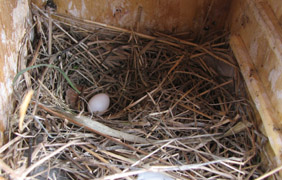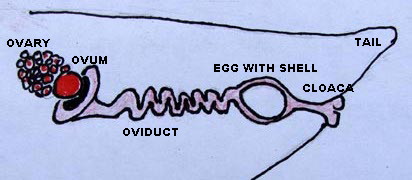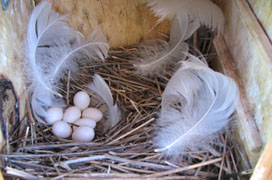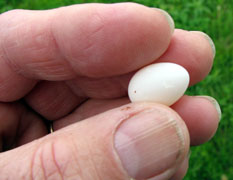At Your Boxes:
For weeks you’ve probably been wondering: Where are the eggs? Is egg laying ever going to begin in these Tree Swallows? Well, the day has come; they finally have!

Checking a box and seeing or feeling the first egg of the season is an exciting moment. When you think about it eggs are really pretty amazing things. Pick one up carefully and look at it. With a lot of work by the adults, your good management, and some luck, the gooey contents of that little egg will transform into a free-flying bird in five weeks or so.
Concepts:
- A fertilized bird egg contains genes from both the mother and father, which will “program” the building of an organism, an embryonic bird. Chemical and physical processes of development will change the embryo from a single cell to the partially grown bird we will see at hatching.
- Most modern-day female birds have just one ovary and one oviduct, and lay only one egg at a time. This may help keep body weight low for flight, and also avoid the problem of having two large delicate eggs developing at the same time.
- During her egg laying period most female songbirds ovulate or release one ripened egg cell or ovum from her ovary per day. Each ripe ovum consists of a yolk that contains much of the future egg’s raw materials and fuel supply, plus the female’s genetic material which floats like a tiny island disc on the surface of the yolk.
- An ovum is fertilized by a male’s sperm just minutes after ovulation, while the ovum is still near the upper opening of the female’s oviduct. At this point the egg has no “white” or no shell.
- After fertilization, the ovum passes into the tube-like oviduct and starts traveling toward the female’s cloaca.
- As the ovum moves through the oviduct it is covered with the rest of the egg’s components: first by several layers of albumen (white), then the shell membranes, and lastly by the hard shell.
- Finally, the completed egg passes through the cloaca and is expelled from the female’s body into the nest in the act of egg laying.

- This process, from ovulation to egg laying, takes about 24 hours.
- In songbirds, ovulation of the next ripe ovum usually occurs 15-75 minutes after an egg is laid.
A fertilized songbird’s egg possesses the following:
- Genetic instructions from both its parents, encoded in DNA, for “building” a bird. In a fertilized egg, the earliest stages of embryonic development take place within the germinal spot, a light-colored area on the surface of the yolk.
- A yellow yolk packed with fats, proteins, carbohydrates, vitamins, and minerals, which will supply most of the raw materials and energy needed for embryonic development. Yolks also contain immune system components that will help protect the embryo from disease and other trauma.
- A clear or milky-colored albumen or “white,” that supplies water and some nutrients to the embryo. The white also cushions the yolk and embryo and keeps them from drying out.
- Shell membranes that help seal moisture in, and through which oxygen enters the egg and carbon dioxide and other waste gases produced by embryonic metabolism exit.
- A hard but porous shell. The shell helps protect the embryo from environmental threats. It is also a source of minerals during embryo growth and helps exchange gases between the egg and its environment.
- Anti-germ protection for the embryo furnished by the shell and membrane barriers, and by anti-microbial proteins in the albumen.
At home, crack a raw (unfertilized) chicken egg into a bowl and examine both egg and shell. Look for:
- Albumen: the egg white.
- Yolk and the thin membranes surrounding the yolk.
- Germinal Spot: a small white disc on the yolk surface where the embryo would have started to develop.
- Chalazae: white curly structures in the albumen that connect to the yolk and twist as the egg moves, keeping the embryo upright.

Also at home, dissect a hard-boiled chicken egg. Look for:
- Outer and inner shell membranes.
- Air space at large end.
- Albumen.
- Yolk and yolk membranes.
- Germinal spot.
Tree Swallows have been back for six weeks or more. Why did it take so long for females to start laying eggs, and why did they start laying now?
- Tree Swallow eggs are small, usually weighing about 1.8 gm at laying, but female swallows are also small birds, averaging only 20 gm.
- So, each egg weighs about one-tenth the weight of the bird laying it, and females lay between four and seven eggs, one per day.
- Producing all these ripened eggs takes lots of energy and raw materials, which comes ultimately from food females must catch, which takes both time and the right set of environmental conditions.
- Weather must warm up enough to allow a good supply of flying insect food in order for females to build the internal resources necessary for egg production.
- Eventually, females’ bodies do become ready. They pass a hormonal and physical threshold, and egg cells in their ovaries begin ripening, swelling as supplies of yolk form and are added. And laying will follow.
Why don’t all Tree Swallows in an area start laying the same day?
- Genetic differences, and variation in foraging success, physical condition, and age, all affect individual laying thresholds.
How synchronized is laying?
- It varies from place to place, and from year to year, but a majority of females at a project grid usually begin laying within a 10-15-day period. They are normally rather well-synchronized.
- However, there are usually a few that lay either before or after this peak period.
- Late clutches can occur following female replacement due to a death, desertion or takeover.
- Second-year (SY) females, laying for the first time in their lives, usually lay later.
Why do females lay different numbers of eggs?
- Genetic differences, variation in foraging success, physical condition, and age can all affect egg production.
- Weather changes during laying may affect a female’s ability to maintain her egg producing condition. Warm weather means more insect food, which means a female can produce more and larger eggs, all other things being equal.
- Resisting nest takeover attempts can drain reserves and reduce a female’s ability to produce eggs.
- SY females average fewer eggs than older females.
Why do egg-laying female Tree Swallows produce 4-7 eggs? Why not 1 or 2, or 10 or 12? Some other bird species do have egg clutches these sizes.
- Eggs become young that need care and feeding.
- For each species there seems to be a genetically based “best average number” of young, one that over time has allowed adults to leave the most descendants.
- Reasons for a species’ average “clutch size” have been subject of much research, but there is still debate over ultimate causes.

What time of day do Tree Swallows lay eggs?
- Usually about dawn or shortly after.
Warning! During laying do not make box checks before 9:00 A.M. If you disturb females in the act of laying they may desert their nests!
How often are eggs laid?
- Female Tree Swallows lay one egg per day, never more.
- Bad weather may cause a female to skip a day or two.
Is it hard for a female swallow to lay an egg?
- You be the judge. Watch Kathryn Leonardo’s YouTube video of egg laying in Tree Swallows.
- Count the female’s contractions as she tries to expel the egg.
- Can you tell when she’s done? What does she need to do when she’s finished?
What do Tree Swallow eggs look like?
- Tree Swallow eggs are small, averaging only about 1.8 g in weight when first laid.
- They are pure white, but some may appear pinkish for a brief time after laying.
- Their air spaces are visible in the large ends.
- Different females can lay eggs that differ in shape.

Many birds lay eggs that have camouflage markings. Why don’t Tree Swallows?
- We don’t know for certain why many cavity-nesters like Tree Swallows have unmarked eggs.
- Tree Swallow eggs are hidden inside a dark cavity, so perhaps producing eggs with cryptic markings would be a waste of energy since predators aren’t apt to see them anyway.
- On the other hand, perhaps white eggs actually are camouflaged against the background of white feathers of Tree Swallow nests.
- Perhaps white eggs are easier for adults to see in the cavity.
When do we consider that a female swallow has completed her clutch?
- For our record system we consider a clutch complete if there have been no new eggs for three days.
If something happens to a female’s eggs can she lay a second clutch?
- Ornithologists usually consider egg-laying female Tree Swallows “single brooded”. They normally produce only one set of eggs per nesting season.
- A small proportion of females in the most southerly parts of the swallows’ breeding range “double brood.” They nest a second time after successfully raising a first brood.
- Many females produce a second clutch if they lose their first. However, these replacement clutches often have fewer eggs.
- If predators take a female’s first nest, she usually deserts that nest site rather than lay a replacement clutch there.
Questions for the next Topic: Incubation in Tree Swallows
Eggs have the plan and the raw materials to produce embryos, but they need something more before embryonic development can proceed.
- What else do eggs need?
- Where will it come from?
——————————————————————————–
Home: Tree Swallow Nest Box Projects
Creating Tree Swallow Nest Box Projects
Spring Return
Nesting Season Behavior
Song and Calls
Nest Site Claiming
Pair Formation
Nest Building
Bird Flight
Mating and Paternity
Diary of One Season at Salmon Creek
Monitoring Nest Boxes and Keeping Records
Making Box Checks Keeping Box Records Control Sheets Season Summaries Print Sheets
Banding Your Tree Swallows Banding Adults Banding Nestlings
Tree Swallows in Research Research Bibliography Glossary of Terms